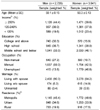Assessment of dietary intake
Dietary intake was estimated from 24-hour dietary recall and a food frequency questionnaire (FFQ). To reflect the Korean dietary preferences, potatoes and legumes were excluded from vegetable consumption, while mushrooms and seaweeds were included.
From the 24-hour dietary recalls we estimated the total amount of FV in the diet, and we categorized the FV intake by botanical family, specific nutrient content, color, and dietary variety. Total fruit included all raw, cooked, canned, frozen, or dried fruit and pure fruit juices, and total vegetable intake included all raw, cooked, canned, frozen or dried forms of most edible vegetables, seaweed, and mushrooms. Because kimchi (a fermented vegetable dish) is a major source of vegetables in the Korean diet, total intake was estimated with and without kimchi vegetables. Botanical families investigated in this study were mushrooms [
20], seaweeds [
21,
22], allium vegetables [
23,
24], cruciferous vegetables [
23,
25], and citrus fruits [
9,
10,
16,
26]. Because of the high proportion of Chinese cabbage and radish in the Korean diet, cruciferous vegetables with/without Chinese cabbage and radish were also included.
The frequency of FV consumption was estimated from FFQs. Fruits included in the FFQs were tangerines, persimmons, pears, watermelons, oriental melons, strawberries, grapes, peaches, apples, bananas and oranges. Vegetables included tomatoes, Chinese cabbage, radishes, soy bean sprouts, spinach, cucumbers, carrots, peppers, squash, seaweeds and mushrooms. The total frequency was calculated for each fruit and vegetable by summing their daily frequencies.
To classify FV as folate-, carotene-, and vitamin C-rich, a Korean food composition database [
27] was used. Nutrient content (per 100 grams of each FV) was ranked for each nutrient, and FV in the highest tertile were considered nutrient-rich [
13]. Thus, folate-rich vegetables were defined as raw, dried, and boiled vegetables including kimchi with folate content ≥ 2,570 µg/100 g, and folate-rich fruits were defined as raw, dried, and frozen fruits and fruit juices with folate ≥ 34 µg/100 g. By this definition, folate-rich vegetables included perilla leaves, carrot, mallow, red pepper, butterbur petiole, pepper leaves,
Ligusticum acutilobum leaves, crown daisy,
Cudrama tricuspidata leaves, mugwort,
Kalopanax pictus leaves, Chinese chive, red paprika, parsley, spinach,
Angelica keiskei, leaf beet (chard), rape,
Acanthopanax senticosus buds,
Amaranthus mangostanus (pig weed), other leafy vegetables (
Pimpinella brachycarpa,
Ligularia fischeri,
Patrinia scabiosefolia,
Aster scaber,
Ailantias altissima,
Solidago vitga aurea), kimchi vegetables (Yeolmukimchi, or young leafy radish and Yuchaekimchi, or young rape leaves), and all forms of seaweed, while folate-rich fruit included strawberry, mango, orange, raspberry, plum, kiwi, and banana.
Carotene-rich vegetables were defined as raw, dried, and boiled vegetables including kimchi with β-carotene content ≥ 109 µg/100 g, and carotene-rich fruits were defined as raw, dried, and frozen fruits and fruit juices with β-carotene ≥ 90 µg/100 g. Carotene-rich vegetables included rape, mustard, Brussels sprout, parsley, royal fern, broccoli, spinach, mugwort, crown daisy, asparagus, shepherd's purse, radish sprouts, bracken, cabbage, kale, welsh onion, water dropwort, lettuce, turnip leaves, chard, Chongkakkimchi (small radish kimchi), and all forms of seaweed, while carotene-rich fruits included persimmon, apricot, kumquat, watermelon, satsuma mandarin, mango, Japanese apricot, raspberry and orange.
Because dried, canned and frozen FV have lower vitamin C contents than their raw counterparts, only raw FV were included in the analysis. Thus, vitamin C-rich vegetables were defined as raw vegetables including kimchi with vitamin C content ≥ 40 mg/100 g, and vitamin C-rich fruits were defined as raw fruits and fruit juices with vitamin C content ≥ 35 mg/100 g. Vitamin C-rich vegetables included Ligusticum acutilobum leaves, caster plant leaves, sweet red pepper, Cudrama tricuspidata leaves, mustard, red pepper, rape, red paprika, cauliflower, broccoli, pepper leaves, kale, Acanthopanax senticosus buds, red mustard, Korean radish, shepherd's purse, green pepper, samchu, Angelica keiskei, spinach, Brussels sprout, lotus roots, young garlic stems, sebalramul, young pumpkin leaves, mallow, pak choi, chicory, celery, Ligularia stenocophala, perilla leaves, leek, royal fern, other leafy vegetables, and kimchi (Yuchaekimchi and Gatkimchi), while vitamin C-rich fruits included citron, longan, Chinese quince, strawberry, lemon, jujube, satsuma mandarin, kumquat, orange, Actinidia arguta, lychee, and grapefruit.
Next, we classified FV by the colors used in other epidemiological studies of chronic diseases [
9,
10,
12] as dark-green leafy vegetables, red fruit and/or vegetables and yellow-orange fruit and/or vegetables. Dark-green leafy vegetables included mustard, sweet potato leaves, chard, spinach, butterbur, mallow,
Angelica keiskei, perilla leaves, chicory, young pumpkin leaves, soybean leaves,
Aster scaber,
Pimpinella brachycarpa, red mustard,
Cudrama tricuspidata leaves,
Ligularia fischeri, and
Ligusticum acutilobum leaves. Yellow/orange vegetables included carrots, yellow/orange paprika, and pumpkin. Red vegetables included tomatoes and tomato products, red pimento, red pepper, red beetroot, and red cabbage. Red fruits included cherry, strawberry, wild berry, watermelon, pomegranate and red apple. Yellow/orange fruits included orange, grapefruit, kumquat, lemon, mandarin orange, tangelo, apricot, persimmon, mango and yellow peach.
Dietary variety scores were calculated separately for fruit and for vegetables. The fruit variety score was the number of different types of fruit consumed, with each type given the score of 1 [
14]. The vegetable variety score was calculated by adding the number of different side dishes that included vegetables as their main ingredient. The side dishes included were Saeng-chae (raw vegetables with seasoning), Na-mul (blanched vegetables with seasoning), and kimchi.








 PDF
PDF ePub
ePub Citation
Citation Print
Print



 XML Download
XML Download